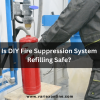![]()
Fire Immuniser
+91-7829629111
Email: info@variex.in
Varistor Technologies Pvt. Ltd.
Block-1, First Floor, Ardente Office One, Hoodi Circle, ITPL Main Road, Bengaluru, Karnataka 560048, IN
How To Operate Fire Fighting Equipment
Proper operation of fire fighting equipment is crucial in effectively responding to and extinguishing fires. Whether you're a trained firefighter or a layperson, knowing how to operate various types of fire fighting equipment can make a significant difference in mitigating fire hazards and protecting lives and property. Here's a guide on how to operate common fire fighting equipment.
Fire Extinguishers:
- Select the appropriate fire extinguisher based on the type of fire (Class A, B, C, D, or K) you are dealing with.
- Remember the acronym "PASS": Pull the pin, Aim the nozzle at the base of the fire, Squeeze the handle, and Sweep the nozzle from side to side until the fire is extinguished.
- Maintain a safe distance from the fire and avoid breathing in smoke or toxic fumes while operating the extinguisher.
Fire Hoses and Nozzles:
- Familiarize yourself with the operation of fire hose reels, cabinets, and hydrants in your building or premises.
- Ensure that the hose is properly connected to a water source and that the nozzle is set to the appropriate spray pattern (solid stream or fog).
- Direct the stream of water at the base of the fire while moving the nozzle from side to side to cover the affected area thoroughly.
Fire Sprinkler Systems:
- Familiarize yourself with the location and operation of sprinkler control valves and alarm panels in your building.
- In case of a fire, do not attempt to manually activate the sprinkler system unless trained to do so. Instead, evacuate the area and alert the fire department immediately.
- After the fire has been extinguished, notify the building management or maintenance personnel to reset the sprinkler system and inspect for any damage or leaks.
Fire Alarm Systems:
- Know the location of manual pull stations and alarm panels in your building and how to activate them in case of an emergency.
- If you discover a fire, pull the nearest fire alarm pull station to alert occupants and initiate the building's evacuation procedure.
- Follow established evacuation routes and assembly points to ensure everyone safely exits the building.
Fire Blankets and Axes:
- Fire blankets can be used to smother small fires or wrap around a person to protect them while escaping from a fire.
- Axes or forcible entry tools may be used to break down doors or walls to gain access to trapped individuals or areas engulfed in flames.
Personal Protective Equipment (PPE):
- Wear appropriate PPE, including fire-resistant clothing, helmets, gloves, and respiratory protection, when operating fire fighting equipment to protect yourself from heat, flames, and hazardous materials.
Training and Practice:
- Regularly participate in fire safety training sessions and drills to familiarize yourself with the operation of fire fighting equipment and emergency procedures.
- Practice using different types of fire extinguishers, hoses, and other equipment under simulated fire conditions to build confidence and proficiency.
Remember, the safety of yourself and others is paramount when operating fire fighting equipment. Always prioritize evacuation and alerting the fire department before attempting to extinguish a fire, and never put yourself in harm's way if the fire is too large or uncontrollable. By understanding how to operate fire fighting equipment and practicing fire safety measures, you can help prevent and mitigate the devastating effects of fires.
Frequently Asked Questions
How do I choose the right fire extinguisher for a fire?
- Select the appropriate fire extinguisher based on the type of fire you're dealing with (Class A, B, C, D, or K). For example, use a Class A extinguisher for ordinary combustibles like wood and paper, and a Class B extinguisher for flammable liquids like grease or gasoline.
What should I do if a fire extinguisher doesn't work when I pull the pin and squeeze the handle?
- If the fire extinguisher fails to discharge when activated, immediately evacuate the area and alert others to the fire. Contact the fire department and report the malfunctioning extinguisher.
How can I ensure that a fire hose is properly connected and ready for use?
- Before operating a fire hose, check that it is properly connected to a water source and that the nozzle is set to the appropriate spray pattern. Conduct regular inspections of fire hoses, nozzles, and fittings to ensure they are in good working condition.
What steps should I take if a fire sprinkler system activates in my building?
- If a fire sprinkler system activates, evacuate the area immediately and notify the fire department. Do not attempt to turn off or reset the sprinkler system unless trained to do so. Follow evacuation procedures and assembly points established for your building.
When should I use a fire blanket, and how do I deploy it effectively?
- Fire blankets are useful for smothering small fires or wrapping around a person to protect them while escaping from a fire. Pull the fire blanket from its container, hold it in front of you to shield your body, and carefully approach the fire to cover it completely.
What precautions should I take when using axes or forcible entry tools in fire fighting?
- Use axes and forcible entry tools with caution and only when necessary to gain access to trapped individuals or areas engulfed in flames. Wear appropriate personal protective equipment (PPE) and follow established procedures for safe tool use.
How often should I participate in fire safety training and drills?
- Fire safety training and drills should be conducted regularly, typically at least once a year or as required by local regulations. Practice using fire fighting equipment under simulated fire conditions to build confidence and ensure readiness in case of an emergency.
What should I do if I encounter a fire that is too large or uncontrollable to extinguish?
- If you encounter a fire that is too large or uncontrollable, evacuate the area immediately and alert others to the fire. Close doors behind you to contain the fire, if possible, and evacuate to a safe location outside the building. Contact the fire department and provide information about the location and size of the fire.
Final Say
We at VariEx.in or Variexonline.com have mastered the art of designing, installing, inspecting, and fixing automatic sprinkler systems with the help of our in-house team, which is capable of delivering the fire sprinkler services you need, whether large or small and at affordable cost.
To schedule a fire sprinkler installation, or you think our services could benefit your commercial property, contact us online or give us a call at, 7829629111










